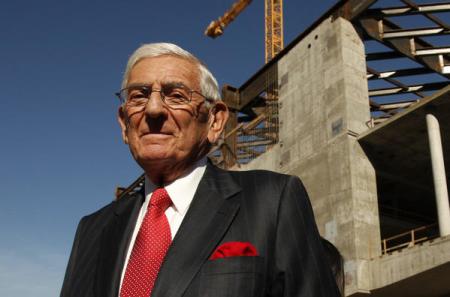Archive for the ‘Broad Art Foundation’ Category
Chapter 3 (Part1): Collector-Created Cultural Capitals
“Los Angeles in my view is becoming the contemporary art capital of the world.”[i] – Eli Broad
LA, or certain people who write about the art scene in LA, or people who get quoted about the art scene in LA, seems to have an inferiority complex. Everything that happens in the arts (a new exhibition, a new art fair, a new museum director…) is deemed the thing that will finally turn LA into an/the art capitol. William Poundstone did a survey of this decades-long mentality[ii] this week inspired by an article in The Economist titled, “2014 may prove a turning point for art museums in Los Angeles.”[iii] But come on – LA, people who write about the art scene in LA, people who get quoted about the art scene in LA, and the people of LA have nothing to prove. The Getty squashed that issue a few years ago, didn’t it?
Back in 2011, the Getty’s ten-years-in-the-making endeavor, Pacific Standard Time (or PST as it has come to be known) opened. Over 60 institutions across Southern California presented exhibitions focused on the region’s art scene between the years of 1945 and 1980. The Getty’s goal was to record, preserve, and present the many contributions Southern Californian artists and arts organizations made to contemporary art during the time period. Initial grants were given to arts organizations to catalogue archives from the period, followed by exhibition grants. Some of these exhibitions traveled to other venues in the country and some traveled internationally. Catalogues from these exhibitions were published and quickly integrated into university curriculums. Besides this trove of scholarship, another goal of PST was to present Los Angeles as an artistic capital.
Chapter 2 (Part 3): Venture Philanthropy & Other Styles of Giving
“Andrew Carnegie said, ‘He who dies with wealth dies in shame.’ And someone once said, ‘He who gives while he lives also knows where it goes.’”[i] – Eli Broad
Eli Broad’s power is tolerated because it remains remarkably unchallenged. This seemingly monopoly of philanthropic power led Christopher Knight to compare Broad to another infamous, Los Angeles art patron:
[Norton] Simon’s flirtations with giving [his] collection away (to at least seven institutions); distrust of traditional museum management; engineering of a bailout of an artistically adventuresome but financially faltering institution (the old Pasadena Museum for Simon, MOCA for Broad); later deciding to open his own museum, and more…[ii]
Another similarity to Broad: Before Norton Simon’s takeover of the Pasadena Art Museum, Simon had intended to establish his collection as a lending organization. Taking control of the Pasadena Art Museum proved irresistible to Simon, and today the Norton Simon Museum rarely loans works. I seriously doubt unfounded rumors that Broad has some kind of evil master plan to takeover or somehow combine his collections with MOCA.
Broad can also be measured to his contemporaries. Los Angeles is not actually a one-philanthropist town. “Pomegranate Queen” Lynda Resnick is an easy comparison. Like Broad, Resnick is a long-time donor and trustee of LACMA. Like Broad, she and her husband provided funds ($54 million) for a Renzo-Piano-designed building at LACMA. The Lynda and Stuart Resnick Pavilion was part of Phase 2 of LACMA’s Transformation and sits directly north of BCAM. When the pavilion opened in October of 2010, one of three inaugural shows was gleaned from the Resnick’s private collection.
Chapter 2 (Part 2): The Race for The Broad – A Tale of Three Cities
“I think what Santa Monica has to offer is an incredible audience, a prime location and willingness to work with the Broads.”[i] – Kevin McKeown, Santa Monica City Councilman
Within just a few months of BCAM’s opening at LACMA, rumors began to circulate that Eli Broad had been less than forthcoming about his true intentions. Contrary to his initial denial of it, at the end of 2008 local newspapers began reporting Broad intended to build a new museum for his collections in Beverly Hills.[ii] The City of Beverly Hills quickly identified a prominent parcel of land at the intersections of Wilshire and Santa Monica Boulevards for the project. An architectural competition was announced, a short list determined (Thom Mayne, Jean Nouvel, Shigeru Ban, Rafael Viñoly and Christian Portzamparc), and schematic renderings of the site plan were even published. [iii] If this speedy development seemed too good to be true, it’s because it was.
By the end of 2009, Broad announced that there were actually multiple cities vying for his collections and a new museum building to house them. Beverly Hills, previously unchallenged was suddenly competing with the City of Santa Monica, and Broad’s foundation announced there was also a third, unnamed city in the running.[iv] This of course turned out to be the City of Los Angeles. Broad said he wasn’t, “trying to play the two [three] municipalities against each other […] he hope[d] that by talking to several different cities he c[ould] accelerate the process of building.”[v] But play them against each other he did, for six months, trying to secure the best deal.




